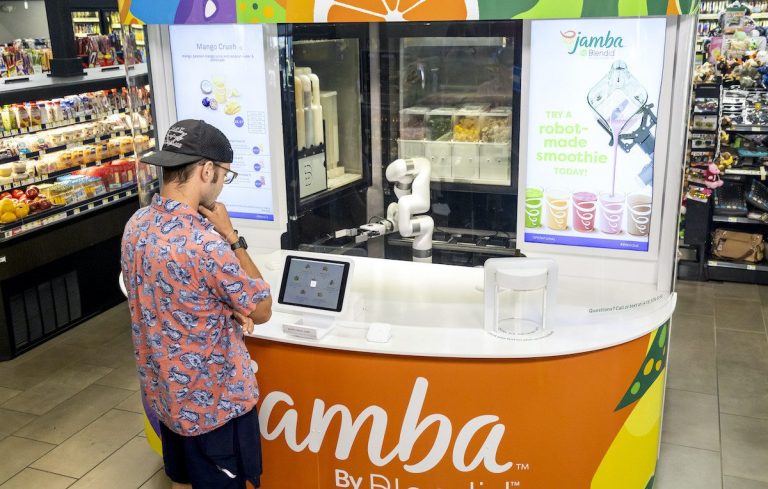
As efficiency-seeking restaurants test out automated technologies, Jamba is seeing its robotic kiosks prove promising.
In an interview with PYMNTS, Geoff Henry, president of the chain known for its smoothies and juices, among other items, spoke to the progress of the brand’s partnership with autonomous robotic food service kiosk creator Blendid to create automated smoothie shops, noting positive responses from consumers who have tried it.
“The repeat rate has been very high,” Henry said. “We’re obviously tracking those who purchase and then come back and purchase again [and] benchmarking that relative to what we would expect versus industry standards, and we’ve been pleased.”
Jamba currently has eight such kiosks up and running at a variety of locations including colleges and universities, travel centers, healthcare facilities and shopping centers. Henry noted that, given younger consumers’ amenability to new technologies, students tend to be the quickest to get onboard. While adoption “varies a little bit from channel to channel,” he contends that the majority of consumers are “absolutely ready” for this kind of robotic restaurant.
These promising early results suggest that fully robotic locations of this kind could be a viable way for certain kinds of restaurants to bring in revenue without the cost of labor, which would be especially valuable in times of staffing challenges and wage inflation.
The preliminary success of this years-long effort also marks a contrast to some tests of automated restaurant technologies taken up more recently, especially those that brands rushed to deployed in the midst of the industry-wide labor crisis.
For instance, in August, casual dining chain Chili’s said it was pausing its test of Bear Robotics’ robotic server technology, pulling these robo-waiters out of some locations, leaving them in operation at others and not expanding them to any new sites.
Moreover, for locations trying out automated technology that have not gone fully autonomous, these efforts could even place additional pressure on staffing. The 2022 edition of PYMNTS’ “Restaurant Readiness Index,” which was created in collaboration with Paytronix and drew from a survey of more than 500 quick-service and full-service restaurant managers across the country, revealed that restaurants that are highly reliant on automation have a more difficult time with hiring and retention than those that are not.
On the consumer side, the increase in digital ordering makes fully automated locations such as Jamba’s possible. Henry notes that, for Jamba, the rise in the digital mix over the last several years has helped prime consumers for this kind of system.
PYMNTS research finds that digital engagement is on the rise, especially with those college-age students. Research from the latest edition of PYMNTS’ ConnectedEconomy™ report, “The ConnectedEconomy™ Monthly Series: Meet The Zillennials,” which draws from a November survey of a census-balanced panel nearly 4,000 U.S. consumers, reveals that 69% of the Gen Z population engages digitally with restaurants.
These figures mark a significant improvement from a year ago. PYMNTS’ October study “Super Apps for the Super Connected,” created in collaboration with PayPal, which drew from a January survey of more than 9,900 consumers across the United States, the United Kingdom, Australia and Germany, found that only 61% of gen Z consumers ordered digitally.
With this rise in digital adoption, Jamba is looking to expand its robotic kiosks.
“We’re super proud of the progress we’ve made, but we’re only in eight locations,” Henry said. “We can easily be in a multiple of that year six or nine months down the road. [So] far, our focus has really been in you know limited geographies, to learn, particularly in California and here in Georgia, but we would anticipate getting into more states in the next 12 months.”